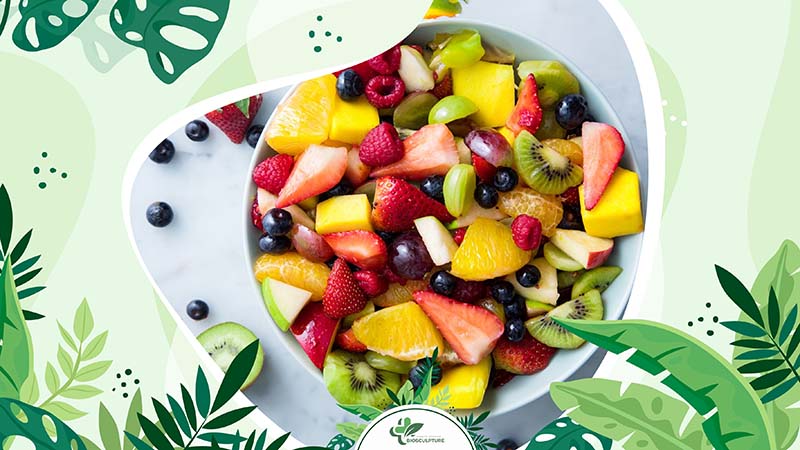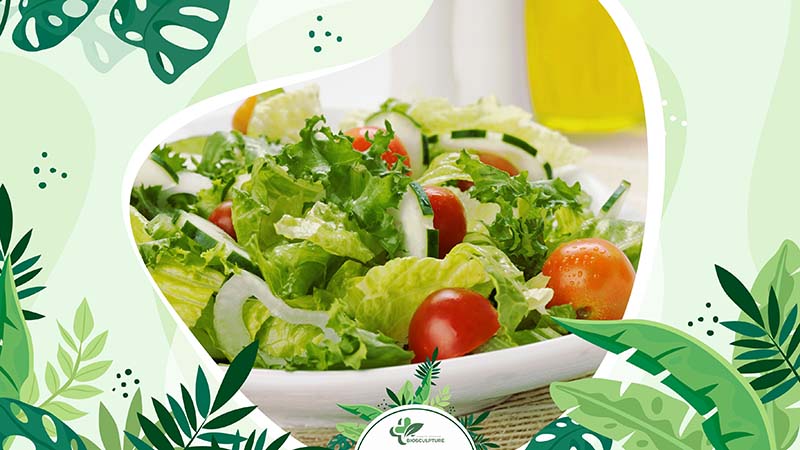Salad, a staple dish rich with a variety of vegetables and fruits, often dressed with unique sauces or common spices, offers flexible additions such as meats, eggs, and sausages. Popular among those pursuing a healthy lifestyle, particularly for weight management, salads are a versatile choice. However, the question of ‘How Many Calories are in a Salad?’ remains elusive for many. At Biosculpture, we aim to demystify the nutritional content of your favorite salads, helping you make informed choices tailored to your dietary needs.

1. what Does a Salad Contain?
Salads encompass a diverse range of dishes falling into several main categories:
- Green Salads: These typically feature leafy vegetables like various types of lettuce, garden cress, watercress, endives, cabbage, spinach, escarole, romaine (cos), arugula, and fresh herbs.
- Vegetable Salads: These include raw or cooked vegetables such as tomatoes, onions, cucumbers, peppers, beets, and more.

- Salads of Pasta, Legumes, or Grains: Incorporating ingredients like pasta, beans, lentils, rice, or other grains.
- Mixed Salads: These combine meats, poultry, seafood, or a mixture of these proteins with vegetables.
- Fruit Salads: Comprising a variety of fresh fruits.

While most salads are typically served cold, some, like German potato salad, can be served hot.
2. Caloric Content of a Salad
Salads come in a multitude of varieties, with different ingredients, toppings, and dressings contributing to their calorie content. A classic example is a green salad, often associated with healthy eating. It typically comprises lettuce, chopped onions, tomatoes, a diced hard-boiled egg, and 1/2 cup of low-fat grated white cheese.
Here’s the breakdown of the calorie content for each ingredient:
- Lettuce and onions: 16 calories per serving
- Tomato: 22 calories
- Egg: approximately 78 calories
- White cheese: approximately 100 calories
So, altogether, a standard serving of this healthy salad contains about 235 calories. Adding a few tablespoons of Italian salad dressing can tack on an extra 30 to 120 calories. It’s worth noting that just one tablespoon of olive oil, a common ingredient in Italian dressing, contains about 100-120 calories.
3. The Benefits of Eating Salad
Eating salad has many benefits for overall health and well-being. Here are the top benefits of eating salad:
- Soluble Fiber for Blood Sugar and Cholesterol: Soluble fiber in salads slows sugar absorption into the bloodstream and reduces the buildup of bad cholesterol, addressing two major concerns in today’s world: diabetes and cardiac problems.
- Insoluble Fiber for Digestive Health: Insoluble fiber from vegetable skins and seeds adds bulk to the digestive process, preventing issues like constipation, diverticulitis, and ulcerative colitis.
- Weight Management: Low-calorie, high-bulk salads provide satiety while aiding in weight loss and management. They offer essential nutrients without excess calories, helping individuals achieve a slimmer yet toned physique.

- Muscle Strengthening: Salad vegetables like spinach contain nitrates that promote protein production in muscles, enhancing strength and efficiency. Additionally, vegetables provide potassium for better muscle health.
- Boosted Immune System: Colorful vegetables rich in antioxidants enhance and bolster the immune system, providing regular defense against illnesses.
- Disease Prevention: High-fiber diets from salads not only reduce the risk of cardiac problems and diabetes but also offer protection against cancer, reflux, ulcers, and other diseases.
- Improved Eyesight: Certain salads rich in vitamin A, carotenoids, lutein, and zeaxanthin—found in carrots, peppers, and leafy greens—can sharpen eyesight and protect against damage from high-energy light, benefiting those who spend long hours staring at screens.

- Reduced Food Cravings: Regular salad consumption can gradually reduce cravings for fatty foods. Eating a small salad before a meal helps prevent overeating, especially when it includes proteins like chicken, eggs, or nuts that aid in digestion.
- Quick and Easy Meals: Salads require minimal culinary expertise and are quick to prepare, making them ideal for busy individuals seeking a healthy meal option. Simply assemble ingredients, add herbs and seasoning, and your meal is ready to enjoy.
- Better Sleep: Greens like lettuce contain lectucarium, a compound known to induce sleep. Incorporating salads into your diet can help combat stress-induced sleep problems and promote better sleep patterns.

4. The Best Time to Eat Salad for Weight Loss
While meal timing isn’t one-size-fits-all, evidence suggests that adjusting your eating patterns may offer health benefits, including enhanced weight loss. Here’s a guide:
- Eat Breakfast, Anytime: Enjoying a salad for breakfast can kickstart your day on a healthy note. It helps you feel full and satisfied until lunch, reducing the urge for unhealthy snacks later on.
- Prioritize Early Day Consumption: Aim to consume the majority of your calories and nutrients earlier in the day, ideally by mid-afternoon. There’s flexibility in how you achieve this. Some may prefer a traditional breakfast, lunch, and snacks, while others might opt for a substantial brunch and one snack.
- Light and Early Dinner: Consider having dinner as early as 4 or 5 p.m. if possible. Eating earlier allows for better digestion and may prevent overeating before bedtime. However, if an early dinner isn’t feasible, aim to eat at least three hours before bedtime to avoid discomfort and promote better sleep quality.

5. Effective Ways to Consume Salad for Weight Loss
Here are five delicious and nutritious salad recipes designed to support your weight loss journey:
Radish Salad:
- Ingredients:
- Thinly sliced radishes
- Sliced onions
- 3 tablespoons fresh lime juice
- 1 tablespoon olive oil
- 1 teaspoon sugar
- Salt and pepper
- Instructions:
-
- Mix lime juice, olive oil, and sugar until sugar dissolves.
- Add radishes and onions to a salad bowl.
- Season with salt and pepper, then toss.
- Chill for 30 minutes before serving.
Chicken Salad:
- Ingredients:
- Boiled chicken
- Choice of vegetables
- Salt
- Pepper
- Instructions:
-
- Mix boiled chicken with diced vegetables.
- Season with salt and pepper.
- Refrigerate before serving.

Chopped Vegetable Salad:
- Ingredients:
- 4 cups chopped lettuce
- 2 cups chopped carrot
- 1 chopped red pepper
- 1 cup chopped onion
- 1 crushed garlic clove
- 2 tablespoons apple cider vinegar
- 3 tablespoons olive oil
- 1 teaspoon salt
- 1/2 teaspoon black pepper
- Instructions:
- Combine chopped vegetables in a bowl.
- Whisk garlic and vinegar with olive oil.
- Add salt and pepper, mix well.
- Chill before serving.
Fruit Salad:
- Ingredients:
- Half apple
- Watermelon
- Melon
- Half banana
- Papaya
- 1 teaspoon flax seeds
- 1 teaspoon pumpkin seeds
- 1 teaspoon chia seeds
- Instructions:
- Dice fruits and combine in a bowl.
- Add seeds for extra nutrients.
- Mix and add a pinch of salt if desired.
- Optionally, include coconut water for hydration.
Cabbage Salad with Peanut Butter:
- Ingredients:
-
- Thinly shredded cabbage
- Fresh basil leaves
- 1 diced avocado
- Roasted chopped cashews
- 2 tablespoons black sesame seeds
- 2 tablespoons peanut butter
- 1 teaspoon sesame oil
- 1 teaspoon soy sauce
- 1 crushed garlic clove
- 1 teaspoon ginger
- 2 tablespoons water
- 1 teaspoon honey
- Instructions:
- Combine vegetables and herbs in a bowl.
- Mix peanut butter, sesame oil, soy sauce, honey, sriracha, garlic, ginger, and water.
- Toss with vegetables, then add cashews and sesame seeds.
- Enjoy this flavorful salad, preferably during breakfast for a nutritious start to your day.
6. Conclusion
In conclusion, salads are frequently chosen for their health benefits and potential to aid in weight loss. However, the nutritional value and calorie content of salads can differ significantly based on the ingredients included. To better understand ‘How Many Calories are in a Salad?’ and to maximize the nutritional impact of your meals, opt for green salads rich in a variety of vegetables and a reliable source of protein.


